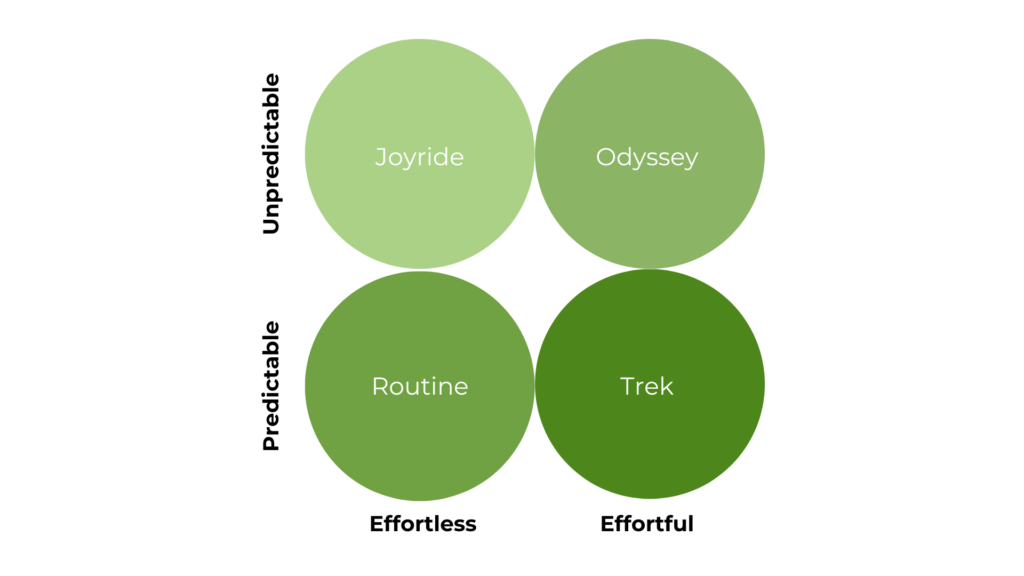Understanding consumer behaviour is crucial as digital technology continues to reshape the retail industry. Every click, view, and scroll by a potential customer holds significant value. The journey from browsing a website to finally hitting the ‘Buy’ button is intricate, often driven by many factors that marketers need to comprehend.
This is why market research becomes the compass guiding brands to understand and influence buying behaviours.
But first, let’s step back and explore the fundamental questions: When and why do consumers decide to buy?
The Transformative World of Shopping
In the last two decades, the retail environment has witnessed remarkable shifts that have redefined the shopping experience. These subtle and significant transitions have reshaped consumer behaviour and posed challenges and opportunities for marketers.
Let’s delve into the four primary areas where change has been most profound:
- Empowerment through Knowledge: The modern consumer is armed with information. With uninterrupted access to many sources, shoppers today often possess insights about products, brands, and pricing that even some sales professionals might lack. This vast knowledge base enables them to make well-informed purchasing decisions.
- Lifestyle Evolution: The globalised world has reshaped lifestyles with its swift information flow. New entertainment forms vie for the same attention and dollars that shopping once monopolised. The accelerated pace of life, coupled with global influences, has heightened the impact of social dynamics on purchasing decisions.
- Technological Revolution: The digital age, with its internet accessibility, mobile innovations, and social media platforms, has opened up novel shopping avenues, like showrooming and webrooming. Moreover, these advancements have equipped researchers with invaluable consumer behaviour and preference data.
- Structural Overhaul: There’s been an explosion in product variety and brand choices available to consumers. The emergence of omnichannel retailing has necessitated a rethink in marketing strategies, compelling consumers to juggle choices across products, brands, and online shopping platforms.
The Modern Buyer’s Journey
Gone are the days when shopping was a linear affair, often constrained by physical boundaries. The digital age presents a multifaceted buying process, marked by multiple touchpoints ranging from social media ads to email marketing and decision-making moments that can make or break a sale. Understanding this nuanced journey is crucial for any brand aiming to thrive online.
A Deeper Dive into the Shopper’s Journey
Marketers often question the moment consumers convert from mere interest to a purchase. “Why do they shop?” and “What sparks that transition from browsing to buying?” are common conundrums,
The significance of these inquiries is evident from the many decision frameworks and choice models that have tried to define consumer shopping habits.
However, the retail sector has drastically evolved. These transformations, driven by technological advancements, societal shifts, and market changes, have reshaped consumer behavior, prompting new questions about why and how people buy.
No longer is the consumer journey a linear path but a myriad of touchpoints filled with decisions, micro-moments, and varying motivations.
Existing shopper journey models, while insightful, may not entirely capture this complexity. For instance, the exponential growth of e-commerce, the influence of peer reviews, and the convenience of mobile searches have created a multifaceted environment where traditional models might fall short.
Retailers need a more comprehensive picture of today’s consumers, focusing on their motivations and the various paths they take when shopping. Within this paradigm are four main archetypes, and we will discuss the design principles to guide each one.
The Four Customer Journey Archetypes and Design Principles

Understanding a customer’s journey to buy your product or use your service is essential for improving user experience and your bottom line.
Brand managers can distil customer journeys into four archetypes to simplify the complex web of possibilities. Each demands a unique design principle to optimise the experience.
Routine: Effortless and Predictable
In a routine journey, the customer knows exactly what they want and how to get it. There’s no fuss, no overwhelming choices—just a straight path to the product or service.
Design Principles: Simplification and Efficiency
What Brands can do: Simplify the process as much as possible. Employ intuitive navigation and a clean UI on your website. For services, consider subscription models that automatically renew, sparing the customer the need to revisit their decision each time.
Joyride: Effortless and Unpredictable
A joyride is all about exceeding customer expectations in unexpected ways. They aren’t just buying a product; they’re buying into a delightful experience.
Design Principles: Surprise and Delight
What Brands can do: Offer unexpected perks, like free same-day shipping or bonus loyalty points. Use AI to offer personalised product suggestions. The goal is to make the customer feel delighted by the extra value you provide, turning a routine interaction into a joyride.
Trek: Effortful and Predictable
Customers are willing to put in the effort in a trek but expect a reliable outcome. Often seen in industries like insurance, healthcare, or complex B2B services, the purchase process may be long, but the steps are standardised.
Design Principles: Guidance and Reliability
What Brands can do: Provide a robust FAQ section, live chat support, or even dedicated customer service agents. Streamline the steps needed to complete a purchase or reach a solution, and ensure each step is transparent and leads to a predictable outcome.
Odyssey: Effortful and Unpredictable
Customers are not only investing effort but are also uncertain about what exactly awaits them. This is common in sectors like travel and adventure, personalised products, or unique, high-end experiences.
Design Principles: Adventure and Discovery
What Brands can do: Use storytelling, rich media, and interactive elements to make the process engaging. While the journey is complex, each touchpoint should offer something valuable, like advice or an exciting preview of what’s to come.
Crafting the Ideal Customer-Journey Map Through Data-Driven Market Research
Customer journey maps offer a visual guide that outlines a person’s steps to accomplish a specific goal. To ensure these maps resonate and drive action, they must be grounded in reality, not idealistic scenarios.
Identify the Archetype
Start by identifying which of the four archetypes best suits the customer journey for your product or service. You may find that different aspects of your marketing align with different archetypes.
Align Your Strategy
Once you know the archetype, align all aspects of your customer interaction model—from marketing to sales to customer service—around the design principles for that archetype.
Audit and Iterate
Continually assess the customer journey to ensure it aligns with the intended archetype. Gather customer feedback and track metrics like Net Promoter Score (NPS) or Customer Satisfaction Score (CSAT) to measure your success.
Adapt
Keep an eye on market trends, new technologies, and customer behaviour. Be prepared to pivot your strategy to a different archetype if needed.
Understanding these archetypes and their corresponding design principles provides a robust framework for creating customer journeys that meet and exceed customer expectations. Whether your customer is on a routine or an odyssey, the ultimate goal is to make their journey with your brand memorable and rewarding.
Market research methods for creating an authentic customer-journey map.
You might wonder why you can’t rely on stakeholder input to construct a journey map. While stakeholders provide valuable insights, their view is often too narrow to completely understand the entire customer journey and the varying user needs at each step. A journey map solely based on assumptions can result in:
- Less credibility, diminishing its potential as a tool for change.
- Incorrect decision-making that could either improve or worsen the customer experience.
The steps outlined below will ensure you check all the boxes to improve the Shopper experience of your brand.
Step 1: Start with Existing Data
Before diving into new research, explore any existing data within your company that might be pertinent to the customer journey. Both qualitative data (like previous focus group results) and quantitative data (such as customer satisfaction scores) can offer valuable starting points for your research.
Step 2: Prioritise Qualitative Research
While existing quantitative data can offer a general idea of customer attitudes, they often lack the depth needed for a comprehensive journey map. For a more nuanced understanding, employ qualitative research methods such as:
- Customer or User Interviews: These provide firsthand accounts of customer experiences and concerns. Specific questions yield more insightful answers than broad ones.
- Field Studies: Observing customers in their natural settings is crucial for authentic insights, allowing you to compare what customers say versus what they do.
- Competitive Analysis: If your product or service is still in the conceptual stage, studying competitors can offer vital clues about what could work for your journey map.
Planning a Multi-Faceted Qualitative Research Study
When possible, employ a mix of qualitative methods to get a multi-dimensional understanding of the customer journey. For instance:
- In-person User Interviews: Begin with direct conversations, using visual aids like sticky notes to help participants articulate their journey.
- Field Studies / Focus Groups: Complement interviews by observing users in their actual environments.
- Competitive Analysis: Analyse competitor customer journeys to benchmark your own.
Complement with Quantitative Data
Once qualitative research is complete, reinforce your findings with quantitative data. For instance:
- Surveys can quantify behaviours and attitudes discovered during interviews.
- Web analytics can highlight areas where users are most frustrated.
- Customer satisfaction metrics can correlate with specific interactions within the journey.
To kickstart your customer-journey research initiative:
- Explore existing internal data to help shape your research focus.
- Use a combination of qualitative research methods for a comprehensive view.
- Bolster qualitative insights with quantitative data for a well-rounded map.
Always keep key stakeholders in the loop throughout the research process. Their involvement fosters greater commitment to the data, reducing reliance on assumptions.
The Role of Market Research
Market research is the bridge that connects companies with consumers, providing invaluable insights. Researchers use many different methodologies depending on the goals:
- Qualitative research provides in-depth insights into consumer behaviours and motivations.
- Quantitative research offers statistical data about markets, competitors, and consumers.
- Primary research entails firsthand data collection tailored to specific business needs.
- Secondary research utilises existing data and research for insights.
Linking these research methods with actionable marketing strategies allows retail brands to cater to their audience more effectively.
Consumer Insights
Why did Jane abandon her shopping cart last night? Why does John oscillate between brands A and B? These are critical questions retail brands grapple with.
Delving deep into the consumer psyche reveals answers. Micro-moments — those brief instances when consumers turn to their devices for quick answers significantly shape the purchase journey. Recognising and optimising for these moments can make all the difference.
Strategies to Boost Conversions
So, knowing the modern consumer’s purchase journey, how can retail brands cater to them and boost sales?
- Personalisation and Tailored Marketing: Segmenting audiences using market research and crafting personalised campaigns speaks directly to individual needs and preferences.
- Enhancing User Experience (UX): A seamless, intuitive user experience can significantly reduce cart abandonment. Market research identifies areas of friction and facilitates improvements.
- Effective Pricing Strategies: With market data, brands can set competitive prices, offering discounts or incentives precisely when they’re most impactful.
- Content Optimisation: By understanding consumers’ needs and concerns, brands can craft content that attracts and converts.
Translating raw data into actionable strategies is often challenging. It’s essential to discern between actionable insights and mere data noise. Ensuring that teams are aligned, and strategies are iteratively tested can pave the way for success.
Market research is not merely a tool; it’s the foundation of successful digital marketing. By understanding and leveraging its insights, brands can guide the casual browser seamlessly from browsing to purchasing. It’s an investment that reaps dividends in higher sales and enhanced brand value and loyalty.
For a deep dive into the future of online shopping and the key trends in the eCommerce space, download our full report here.
Get regular insights
Keep up to date with the latest insights from our research as well as all our company news in our free monthly newsletter.




 Senior Marketing Executive
Senior Marketing Executive Sales & Marketing
Sales & Marketing General Manager PR -Internal Communications & Government Affairs
General Manager PR -Internal Communications & Government Affairs Vital Strategies
Vital Strategies
 Customer Intelligence Director
Customer Intelligence Director